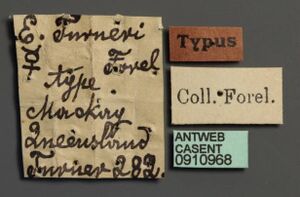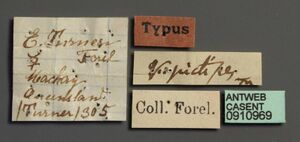Echinopla turneri
| Echinopla turneri | |
|---|---|

| |
| Scientific classification | |
| Kingdom: | Animalia |
| Phylum: | Arthropoda |
| Class: | Insecta |
| Order: | Hymenoptera |
| Family: | Formicidae |
| Subfamily: | Formicinae |
| Tribe: | Camponotini |
| Genus: | Echinopla |
| Species group: | serrata |
| Species: | E. turneri |
| Binomial name | |
| Echinopla turneri Forel, 1901 | |
| Synonyms | |
| |
Identification
A member of the Echinopla serrata group.
Keys including this Species
Distribution
Latitudinal Distribution Pattern
Latitudinal Range: -19° to -24.183°.
| North Temperate |
North Subtropical |
Tropical | South Subtropical |
South Temperate |
- Source: AntMaps
Distribution based on Regional Taxon Lists
Australasian Region: Australia (type locality).
Distribution based on AntMaps
Distribution based on AntWeb specimens
Check data from AntWeb
Countries Occupied
| Number of countries occupied by this species based on AntWiki Regional Taxon Lists. In general, fewer countries occupied indicates a narrower range, while more countries indicates a more widespread species. |

|
Estimated Abundance
| Relative abundance based on number of AntMaps records per species (this species within the purple bar). Fewer records (to the left) indicates a less abundant/encountered species while more records (to the right) indicates more abundant/encountered species. |

|
Elevation Range
| Species | Elevation (m asl) | |||||
|---|---|---|---|---|---|---|
| 200 | 400 | 600 | 800 | 1000 | 1200 | |
| Echinopla turneri | style="color:white;background-color:rgb(190, 190, 190)"|20-30 | |||||
| Shading indicates the bands of elevation where species was recorded. Numbers are the percentage of total samples containing this species. | ||||||
Biology
Castes
Images from AntWeb
   
| |
| Syntype of Echinopla turneri. Worker. Specimen code casent0910968. Photographer Z. Lieberman, uploaded by California Academy of Sciences. | Owned by MHNG, Geneva, Switzerland. |
   
| |
| Syntype of Echinopla turneri pictipes. Worker. Specimen code casent0910969. Photographer Z. Lieberman, uploaded by California Academy of Sciences. | Owned by MHNG, Geneva, Switzerland. |
Nomenclature
The following information is derived from Barry Bolton's Online Catalogue of the Ants of the World.
- pictipes. Echinopla turneri var. pictipes Forel, 1901h: 76 (w.q.) AUSTRALIA. Junior synonym of turneri: Taylor, 1992a: 61.
- turneri. Echinopla turneri Forel, 1901h: 76 (w.q.) AUSTRALIA. Senior synonym of pictipes: Taylor, 1992a: 61.
Type Material
- Syntype, 2 workers, Mackay, Queensland, Australia, Turner, ANIC32-053496, Australian National Insect Collection.
- Syntype, 1 worker, Mackay, Queensland, Australia, Turner, ANIC32-053498, Australian National Insect Collection.
Description
References
- Burwell, C.J., Nakamura, A. 2020. Rainforest ants (Hymenoptera: Formicidae) along an elevational gradient at Eungella in the Clarke Range, Central Queensland coast, Australia. Proceedings of the Royal Society of Queensland 125: 43-63.
- Forel, A. 1901m. Formiciden des Naturhistorischen Museums zu Hamburg. Neue Calyptomyrmex-, Dacryon-, Podomyrma- und Echinopla-Arten. Mitt. Naturhist. Mus. Hambg. 18: 43-82 (page 76, worker, queen described)
- Taylor, R. W. 1992a. Nomenclature and distribution of some Australian and New Guinean ants of the subfamily Formicinae (Hymenoptera: Formicidae). J. Aust. Entomol. Soc. 31: 57-69 (page 61, Senior synonym of pictipes)
- Zettel, H. & Laciny, A. 2017. Further additions to the taxonomy and distribution of the ant genus Echinopla. Annalen des Naturhistorischen Museums in Wien, B, 119: 7-16.
- Xu, Z.-H. & Zhou, X. 2015. Species grouping and key to known species of the ant genus Echinopla Smith (Hymenoptera: Formicidae) with reports of Chinese species. Asian Myrmecology, 7, 19-36.
References based on Global Ant Biodiversity Informatics
- Forel A. 1901. Formiciden des Naturhistorischen Museums zu Hamburg. Neue Calyptomyrmex-, Dacryon-, Podomyrma- und Echinopla-Arten. Mitt. Naturhist. Mus. Hambg. 18: 43-82.
- Taylor R. W. 1992. Nomenclature and distribution of some Australian and New Guinean ants of the subfamily Formicinae (Hymenoptera: Formicidae). Journal of the Australian Entomological Society 31: 57-69.

